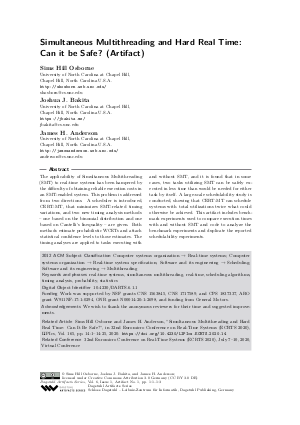Simultaneous Multithreading and Hard Real Time: Can it be Safe? (Artifact)
Authors Sims Hill Osborne, Joshua J. Bakita, James H. Anderson
-
Part of:
Issue:
Special Issue of the 32nd Euromicro Conference on Real-Time Systems (ECRTS 2020)
Part of: Volume: DARTS, Volume 6 (ECOOP 2020)
Part of: Conference: Euromicro Conference on Real-Time Systems (ECRTS)
Part of: Journal: Dagstuhl Artifacts Series (DARTS) - License:
 Creative Commons Attribution 3.0 Unported license
Creative Commons Attribution 3.0 Unported license
- Publication Date: 2020-06-30
Artifact Description

PDF
DARTS.6.1.1.pdf
- Filesize: 353 kB
- 3 pages
Document Identifiers
Subject Classification
ACM Subject Classification
- Computer systems organization → Real-time systems
- Computer systems organization → Real-time system specification
- Software and its engineering → Scheduling
- Software and its engineering → Multithreading
Keywords
- real-time systems
- simultaneous multithreading
- real-time
- scheduling algorithms
- timing analysis
- probability
- statistics
Metrics
- Access Statistics
-
Total Accesses (updated on a weekly basis)
0Document
0Metadata
Artifact
DARTS-6-1-1-artifact-03dd6255f2cee5f39b0977e0cacddd5b.tgz
(Filesize: 0.5 GB)
MD5 Sum:
03dd6255f2cee5f39b0977e0cacddd5b
(Get MD5 Sum)
Abstract
The applicability of Simultaneous Multithreading (SMT) to real-time systems has been hampered by the difficulty of obtaining reliable execution costs in an SMT-enabled system. This problem is addressed from two directions. A scheduler is introduced, CERT-MT, that minimizes SMT-related timing variations, and two new timing analysis methods - one based on the binomial distribution and one based on Cantelli’s Inequality - are given. Both methods estimate probabilistic WCETs and attach statistical confidence levels to those estimates. The timing analyses are applied to tasks executing with and without SMT, and it is found that in some cases, two tasks utilizing SMT can be safely executed in less time than would be needed for either task by itself. A large-scale schedulability study is conducted, showing that CERT-MT can schedule systems with total utilizations twice what could otherwise be achieved. This artifact includes benchmark experiments used to compare execution times with and without SMT and code to analyze the benchmark experiments and duplicate the reported schedulability experiments.
Cite As Get BibTex
Sims Hill Osborne, Joshua J. Bakita, and James H. Anderson. Simultaneous Multithreading and Hard Real Time: Can it be Safe? (Artifact). In Special Issue of the 32nd Euromicro Conference on Real-Time Systems (ECRTS 2020). Dagstuhl Artifacts Series (DARTS), Volume 6, Issue 1, pp. 1:1-1:3, Schloss Dagstuhl – Leibniz-Zentrum für Informatik (2020)
https://doi.org/10.4230/DARTS.6.1.1
BibTex
@Article{osborne_et_al:DARTS.6.1.1,
author = {Osborne, Sims Hill and Bakita, Joshua J. and Anderson, James H.},
title = {{Simultaneous Multithreading and Hard Real Time: Can it be Safe? (Artifact)}},
pages = {1:1--1:3},
journal = {Dagstuhl Artifacts Series},
ISSN = {2509-8195},
year = {2020},
volume = {6},
number = {1},
editor = {Osborne, Sims Hill and Bakita, Joshua J. and Anderson, James H.},
publisher = {Schloss Dagstuhl -- Leibniz-Zentrum f{\"u}r Informatik},
address = {Dagstuhl, Germany},
URL = {https://drops.dagstuhl.de/entities/document/10.4230/DARTS.6.1.1},
URN = {urn:nbn:de:0030-drops-123915},
doi = {10.4230/DARTS.6.1.1},
annote = {Keywords: real-time systems, simultaneous multithreading, real-time, scheduling algorithms, timing analysis, probability, statistics}
}
Author Details
Funding
Work was supported by NSF grants CNS 1563845, CNS 1717589, and CPS 1837337, ARO grant W911NF-17-1-0294, ONR grant N00014-20-1-2698, and funding from General Motors.
Acknowledgements
We wish to thank the anonymous reviewers for their time and suggested improvements.
Related Article
- Sims Hill Osborne and James H. Anderson, "Simultaneous Multithreading and Hard Real Time: Can It Be Safe?", in 32nd Euromicro Conference on Real-Time Systems (ECRTS 2020), LIPIcs, Vol. 165, pp. 14:1 - 14:25, 2020. https://doi.org/10.4230/LIPIcs.ECRTS.2020.14
References
-
H. Falk, S. Altmeyer, P. Hellinckx, B. Lisper, W. Puffitsch, C. Rochange, M. Schoeberl, R. B. Sorensen, P. Wagemann, and S. Wegener. TACLeBench: A Benchmark Collection to Support Worst-Case Execution Time Research. In WCET 2016, pages 2:1-2:10, 2016.

-
S. Osborne and J. H. Anderson. Simultaneous multithreading and hard real time: Can it be safe? In ECRTS 2020 (conditionally accepted), 2020.

-
S. Osborne, J. Bakita, and J. H. Anderson. Simultaneous multithreading applied to real time. In ECRTS '19, 2019.

- S. Osborne, J. Bakita, and J. H. Anderson. Simultaneous Multithreading Applied to Real Time (Artifact). Dagstuhl Artifacts Series, 5(1):8:1-8:2, 2019. URL: https://doi.org/10.4230/DARTS.5.1.8.
